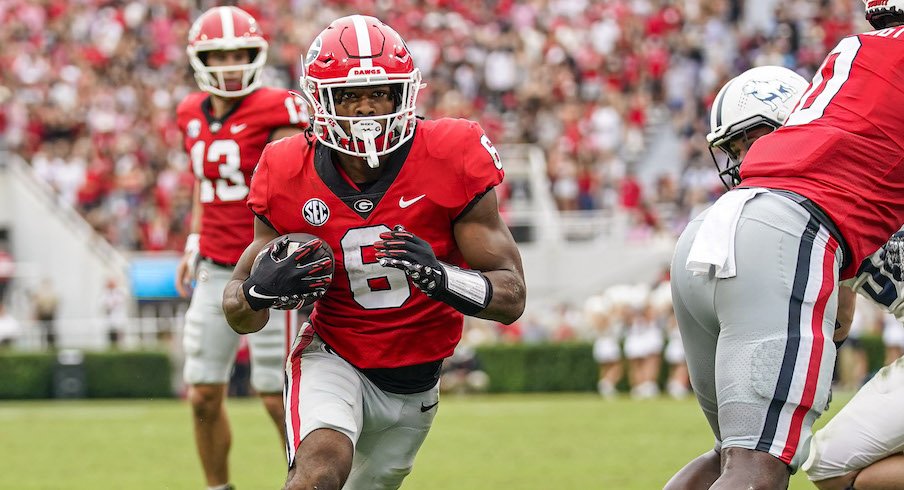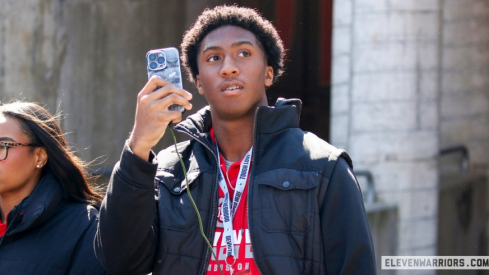Given that Georgia is the No. 1 seed in the College Football Playoff, it’s obvious to say the Bulldogs have a lot of players who are capable of giving Ohio State problems in the Peach Bowl.
The only team currently ranked in the top 10 nationally in both total offense and total defense, Georgia is the most complete team in the country and loaded with what might be the most talented roster in college football. Much like Ohio State, the Bulldogs have four- and five-star recruits all over the field (with former walk-on starting quarterback Stetson Bennett being one notable exception) and players who can be game-changers at just about every position.
As such, Ohio State can’t simply focus on taking a few players out of the game. The Buckeyes will have to be sound in all areas if they’re going to have a chance to upset Georgia and advance to the national championship game. But there are a few Bulldogs on both sides of the ball who particularly stand out.
Ohio State will certainly be well-aware of Bennett after his appearance in New York as a Heisman finalist this past weekend, but we’ll focus on his three most dangerous weapons here as the players who the Buckeyes’ defense will need to be able to limit to keep Georgia from putting up big numbers. On the other side of the ball, we’ll look at three elite talents on defense who have repeatedly caused headaches for opponents that the Buckeyes will need to account for in their offensive game planning.
Offense
TE Brock Bowers
The winner of this year’s John Mackey Award, Bowers isn’t just the best tight end in college football but one of the nation’s most dynamic offensive players.
Bowers has been Georgia’s leading receiver in both of his first two seasons as a Bulldog, catching 108 passes for 1,608 yards and 19 touchdowns over two years. Possessing unusual speed and run-after-catch ability for a tight end, Bowers is always a threat to make a big play over the middle but is also utilized as a receiver out of the backfield and even as a runner, scoring touchdowns on four of his 10 career rushing attempts.
This year’s Ohio State defense has been mostly successful at limiting tight ends who serve as primary receivers like Notre Dame’s Michael Mayer (who Fighting Irish fans felt should have won the Mackey Award over Bowers) and Iowa’s Sam LaPorta. But the Buckeyes did look more vulnerable against tight ends late in the regular season – giving up touchdown receptions to tight ends in each of their last three games – and Bowers is unlike any other tight end in the country.
RB Kenny McIntosh
Georgia has three running backs who have rushed for more than 500 yards and at least six touchdowns this season – McIntosh, Daijun Edwards and Kendall Milton (a name likely familiar to Ohio State fans who follow recruiting closely) – so the Buckeyes can’t prepare for just one running back. All three of them have had at least 100-yard rushing game this season, most recently Milton in the SEC Championship Game against LSU, so any of them are capable of having a big day.
That said, McIntosh has been the Bulldogs’ most consistent threat out of the backfield. He leads Georgia with 709 rushing yards and 10 touchdowns on 137 carries and has been the Bulldogs’ third-leading receiver, catching 37 passes for 449 yards – the second-most receiving yards of any FBS running back – and another touchdown. At 6-foot-1 and 210 pounds, McIntosh shows excellent acceleration out of the backfield and natural receiving ability on both short passes and deep throws while also displaying the strength and agility to both make defenders miss and power through tackles.
In each of Ohio State’s three losses over the past two years, the Buckeyes have allowed an opposing running back (Michigan’s Donovan Edwards this year and Michigan’s Hassan Haskins and Oregon’s CJ Verdell in 2021) to rush for at least 160 yards and score at least two touchdowns. The Buckeyes can’t allow any of Georgia’s running backs to have a day like that, and they’ll need to be particularly aware of the damage McIntosh can do as both a runner and receiver.
TE Darnell Washington
It’s not very often that two tight ends are featured in an article like this, but Washington is no ordinary No. 2 tight end. At 6-foot-7 and 270 pounds, Washington combines offensive lineman-like size with receiver-esque athleticism, and he uses his spectacular physical attributes to be both a playmaker in the passing game and a major asset to the Bulldogs as a run blocker.
Washington isn’t used as frequently as a receiver as Bowers is, but he’s still caught 26 passes for 417 yards and two touchdowns this year. If the Bulldogs decide to target him more regularly against Ohio State, he’s more than capable of having a big game. He’s a player the Buckeyes will need to specifically account for as his height makes him a tough matchup in coverage while his mass makes him a load to tackle in the open field (and he’s even shown the ability to hurdle defenders in space).
Georgia uses a two-tight end formation as its primary offense with both Bowers and Washington as starters, and Jim Knowles will have to determine how the Buckeyes can best account for that, whether that means using more three-linebacker packages with Cody Simon, elevating a bigger safety like Josh Proctor or Sonny Styles into an increased role or relying on starting safeties Ronnie Hickman, Lathan Ransom and Tanner McCalister to handle those matchups.
Defense
DT Jalen Carter
On the latest big board released by ESPN’s Mel Kiper Jr. last week, Carter is ranked as the No. 1 overall prospect in the 2023 NFL draft, which might be all you need to hear to know Carter is the No. 1 defensive player the Buckeyes need to circle on their Peach Bowl scouting report.
With unusual quickness for a 6-foot-3, 300-pound defensive tackle, Carter is a game-wrecker on Georgia’s defensive line who will give Ohio State’s interior offensive line the toughest test it’s faced all season. His box score statistics of 29 total tackles, seven tackles for loss and three sacks don’t jump off the page, but he missed multiple games with injuries and has been at his best in the Bulldogs’ biggest games, recording two tackles for loss and two forced fumbles against Tennessee and two TFLs with a pass breakup in the SEC Championship Game.
Pro Football Focus has graded Carter as the second-best interior defensive lineman in college football this year, and the film shows his disruption goes well beyond the plays that show up on the stat sheet. Double-teaming anyone on Georgia’s playmaker-laden defense can free up other Bulldog defenders to make big plays, but Ohio State might not have a choice if it wants to limit Carter’s impact on the game.
S Christopher Smith
The star of Georgia’s defensive back seven is Smith, who joined Carter in earning first-team All-American honors from the Walter Camp Football Foundation and Football Writers Association of America last week. A physical hitter and a skilled cover safety who is also one of Georgia’s top veteran leaders, Smith has been a vital cog in Georgia’s elite defensive play over the past two seasons.
With 50 tackles, five tackles for loss, five pass breakups, three interceptions and a fumble recovery, Smith has been Georgia’s most consistent defensive playmaker. And like Carter, he’s shown a penchant for stepping up and making big plays in big games – particularly in Georgia’s most recent game, as he had an interception, a pass breakup that was intercepted by a teammate and a 96-yard blocked field goal return for a touchdown in the Bulldogs’ SEC Championship Game win over LSU.
C.J. Stroud and the Buckeyes might be able to exploit some holes in Georgia’s pass defense after LSU threw for 502 yards against the Bulldogs, but opponents haven’t done much throwing in Smith’s direction this year, as he’s allowed only 18 catches for 191 yards in 13 games, per PFF. And with six interceptions over the past two years, Stroud needs to be careful not to force passes Smith’s way, as that could put the Buckeyes at risk of a turnover.
CB Kelee Ringo
The other star of Georgia’s secondary is Ringo, another name Ohio State fans might remember from the Buckeyes’ efforts to recruit him as the No. 1 cornerback in the 2020 class. Ringo chose the Bulldogs instead and has lived up to the hype in Athens, becoming Georgia’s No. 1 cornerback over the past two seasons.
Ringo, who stepped up in a big way on the biggest stage last year when he made a game-sealing 79-yard pick-six in Georgia’s national championship game win over Alabama, hasn’t been quite as dominant on a play-to-play basis this year as he was last year – giving up 35 catches for 478 yards, per PFF – but has not allowed a touchdown all season. He’s continued to put his ball skills on display with two interceptions and six pass breakups, making him a dangerous player to throw 50/50 balls against.
Georgia often puts Ringo on an island against the opponent’s best receiver, which likely means Ringo will spend most of the Peach Bowl matching up with Marvin Harrison Jr. If Harrison can get the best of that matchup and force Georgia to give Ringo more help, that could go a long way toward freeing up Ohio State’s other weapons to make plays. But with five weeks to prepare for this game, Ohio State should also be drawing up creative ways to utilize Harrison to mitigate any efforts by Georgia to take him out of the game.


